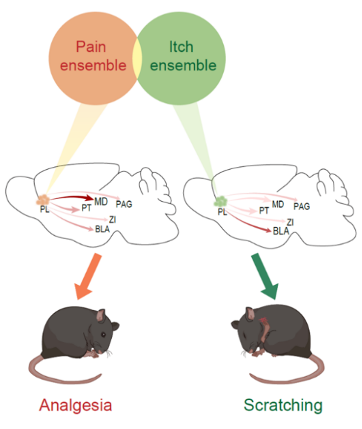The ability to detect harmful stimuli through biological testing is crucial for an individual’s survival. Pain and itch, as essential components of the body’s somatic sensations, aid in defending against external nociceptive stimuli and prevent tissue damage. Despite sharing similar neuroanatomical pathways and involvement in the development of related chronic diseases, pain and itch are fundamentally distinct. These two sensations elicit different neural perception and behavioral responses. However, the mechanism by which the respective information about pain and itch is encoded and processed in the brain to produce distinct sensations remains a scientific question that requires further research.
On May 23, Associate Professor Hu Ji in SLST and his collaborators published a research article entitled “Representation and Control of Pain and Itch by Distinct Prefrontal Neural Ensembles” in Neuron. This paper described the distinct neural ensembles in the medial prefrontal cortex responsible for the separate representation of pain and itch information. It proposed that these two neural ensembles regulate pain or itch-related sensory and emotional behaviors by projecting downstream to specific areas with priority.
This is the first time that researchers utilized the in vivo microendoscopic Ca2+imaging method with single-cell precision to investigate the distinct response patterns of neurons in the medial prefrontal cortex (mPFC) after receiving pruriceptive or nociceptive information. By employing real-time and long-term monitoring of neural activities, Hu’s group discovered that both stimuli could cause complex and diverse calcium signaling activities of excitatory neurons in the prelimbic (PL) subdivision of the mPFC. In-depth data analysis suggested that although pain- and itch-activated PL neurons were anatomically intermixed, they could be distinguished from each other by their responses to pruriceptive or nociceptive information, indicating that pain and itch are encoded and processed by separate groups of neurons in the PL subdivision.
The research team further elucidated the bidirectional regulation of neuronal ensembles specifically labeled as acute pain or acute itch, associated with the pain and itching behaviors of mice by utilizing targeted labeling and manipulation of active neuronal populations. They found that two distinct neuronal populations exists in the PL division that can independently encode pain and itch and regulate pain- and itch-related behavioral outputs in opposite ways.
To further elucidate the heterogeneous characteristics of these two neuronal populations and explore the neural circuits behind their regulation of pain and itch behaviors, the researchers constructed whole-brain input-output projection maps of the two neuronal ensembles activated by pain and itch in the PL region. The experimental results indicated significant differences in the inputs received by these two neuronal populations in some brain areas. Similarly, their output circuits also differed. Furthermore, the researchers demonstrated that the projection from PL to the dorsal medial thalamus negatively regulated pain behavior, while the projection from PL to the basolateral amygdala positively regulated pruritus-related sensory and emotional behaviors.
In conclusion, these findings reveal the separate representation of pain and itch by distinct neuronal populations in the PL division, and provide a comprehensive analysis of the heterogeneous characteristics of cortical neurons activated by pain and itch. This was revealed in various contexts including their anatomical location, functional properties, whole-brain connectivity, response patterns to pruriceptive or nociceptive information, and behavioral outputs. The existence of such heterogeneity at different levels lays the physical foundation for the differential processing of pain and itch in the same area.

Figure: A schematic diagram of the neural mechanism underlying the classification and differential regulation of pain and itch by prefrontal cortical neuron ensembles.
This study which provides new knowledge of the elucidation of the neural mechanisms underlying the classification and encoding of pain and itch that lead to different sensory experiences, forms a new theoretical framework for understanding somatosensory information processing in the brain, and points out a new direction for the treatment of diseases related to pain or itching abnormalities.
Pan Qian, Ph.D. student of SLST, Guo Su-Shan, Ph.D. student of Shanghai Jiao Tong University School of Medicine, and Dr. Chen Ming, Associate Research Professor in SLST (currently the researcher in Institutes of Brain Science, Fudan University) are the co-first authors. Prof. Hu Ji, together with the other two researchers in Shanghai Jiao Tong University School of Medicine, Dr. Liu Ming-Gang and Dr. Xu Tian-Le, are the co-corresponding authors.
**The article is provided by Prof. Hu Ji

